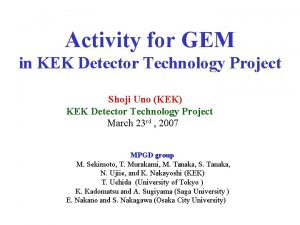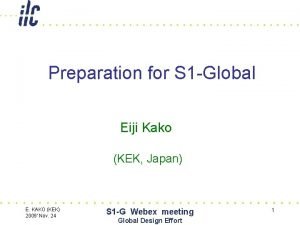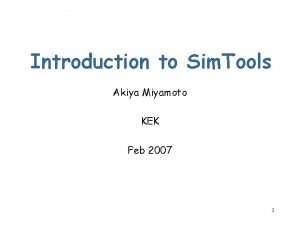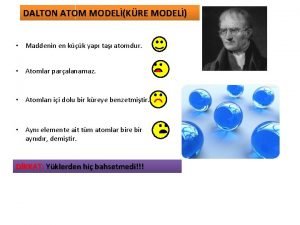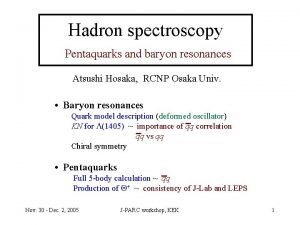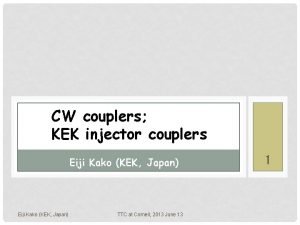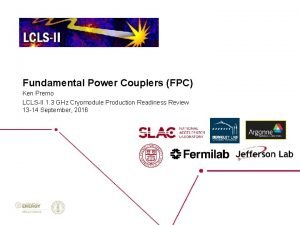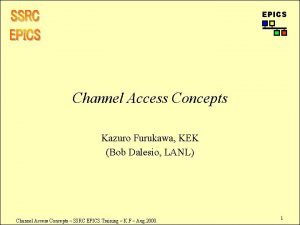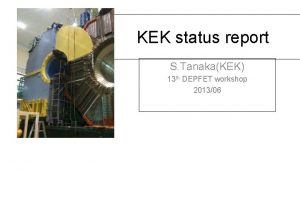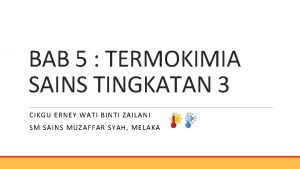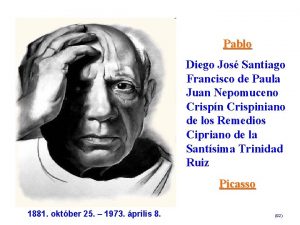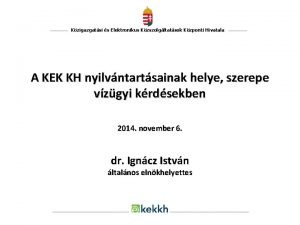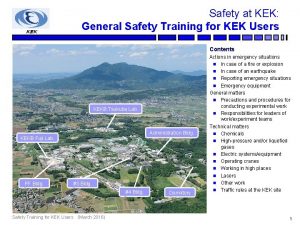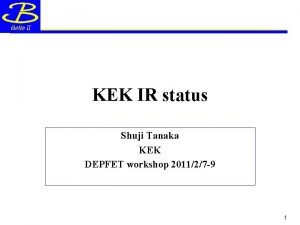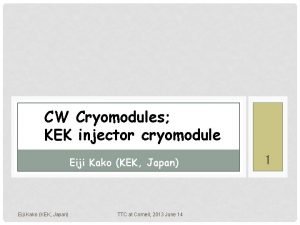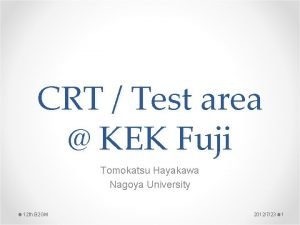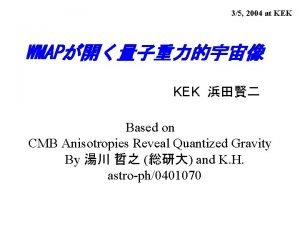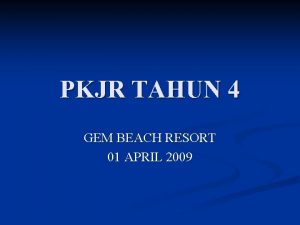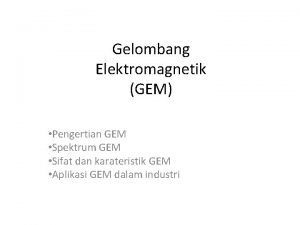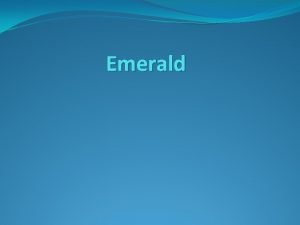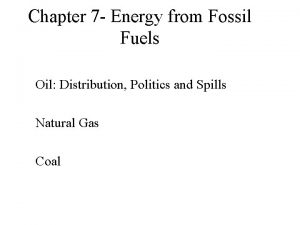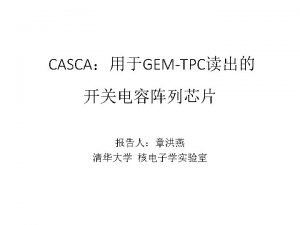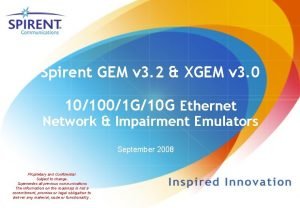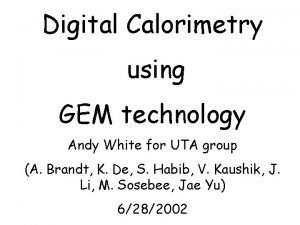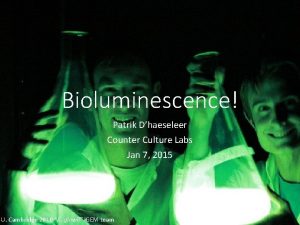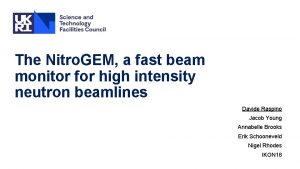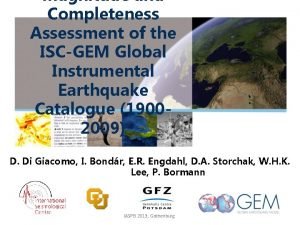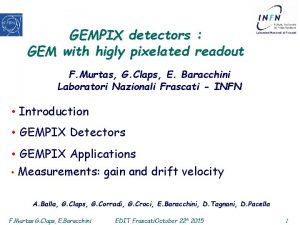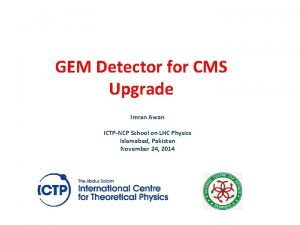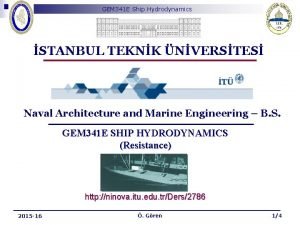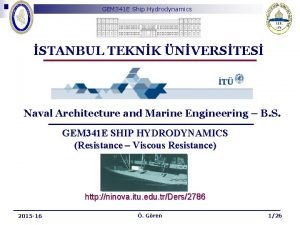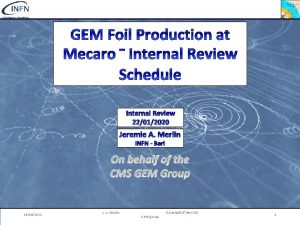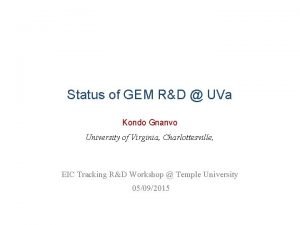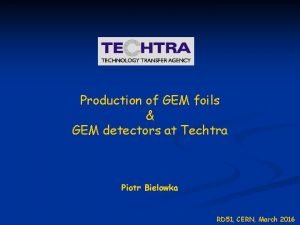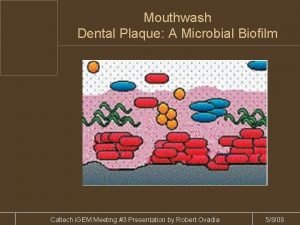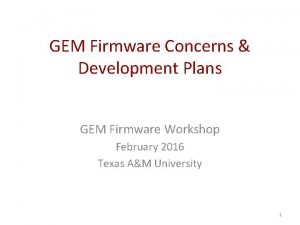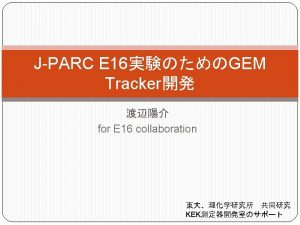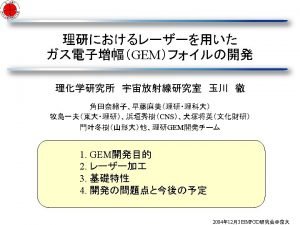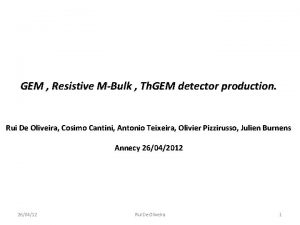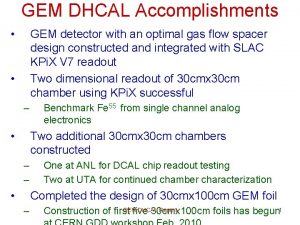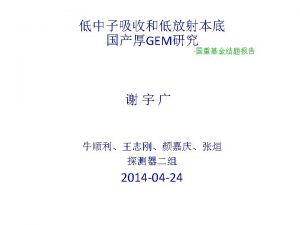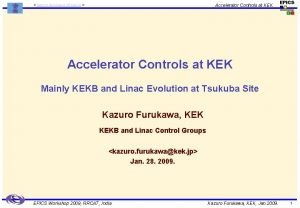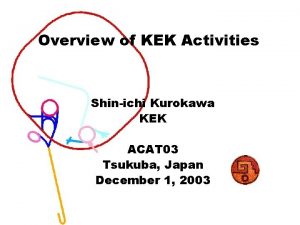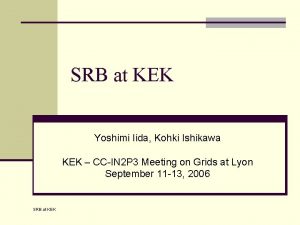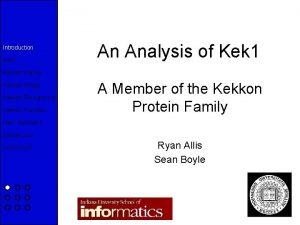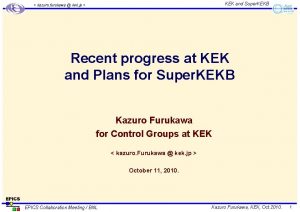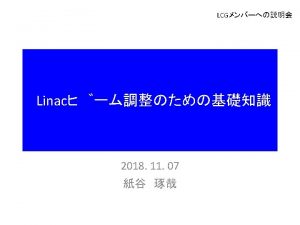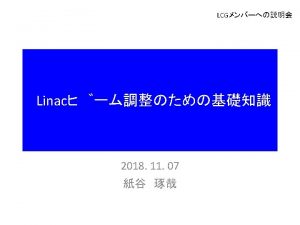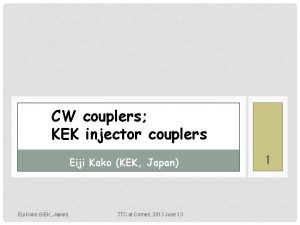Activity for GEM in KEK Detector Technology Project





















































- Slides: 53

Activity for GEM in KEK Detector Technology Project Shoji Uno (KEK) KEK Detector Technology Project March 23 rd , 2007 MPGD group M. Sekimoto, T. Murakami, M. Tanaka, S. Tanaka, N. Ujiie, and K. Nakayoshi (KEK) T. Uchida (University of Tokyo ) K. Kadomatsu and A. Sugiyama (Saga University ) E. Nakano and S. Nakagawa (Osaka City University)

Contents • Basic study of GEM – Effective gas gain – Charge distribution – Thicker GEM : 100 mmt – Recovering for damaged GEM • Applications – Neutron counter

Test Chamber 55 Fe (5. 9 ke. V X-ray) 10 mm GEM 1 GEM 2 GEM 3 PCB 1 mm DRIFT □ 15 mm× 15 mm ~ 2 mm TRANSFER 1 ~ 2 mm TRANSFER 2 ~ 2 mm INDUCTION GAS Ar-CH 4(90/10) (P-10) Ar-CO 2(70/30) 36= 6× 6 2200 p. F

Pulse shape Signal from GEM foil 150 m. V Signal from Readout pad 80 ns

Readout System CLK Gen. (1 MHz) Scaler 1 ms Fanin-Fanout T 0 timing Trg. Gate Reset Coincidence Gate Gen. CCNET Gate Gen. GATE 120μs delay RPN 220 Discr. 5 m Belle-CDC Pre-amp. RPN 220× 7 30 m Belle-CDC Pre-amp. × 7 GATE VETO CAMAC Gate Gen. 4 ms delay Width 40 ms For beam test Timing Information BUSY Gated trg. GATE CAMAC ADC 2249 A× 9

Measurement of Effective Gas Gain

Effective gas gain vs ΔVGEM P 10 Ar-CO 2

Gas gain vs various parameters P 10 Ar-CO 2 EI ED Ar-CO 2 P 10 Ar-CO 2 ET EI

55 Fe (5. 9 ke. V X-ray) ED Drift region Normalized Effective Gain Electric Field Dependence in Drift Region ΔVGEM=360 V ET=1. 6 k. V/cm EI=3. 6 k. V/cm Electric Field in Drift Region (k. V/cm) Low Field in Drift Region ED=500 V/cm High Field in Drift Region ED=3000 V/cm Collection efficiency deceases in higher ΔVGEM=320V electric field, since some electric field lines reach on the surface of GEM. EI=1000 V/cm

55 Fe (5. 9 ke. V X-ray) EI Induction Region Normalized Effective Gain Electric Field Dependence in Induction Region ΔVGEM=350 V ED=1. 3 k. V/cm ET=2. 1 k. V/cm Electric Field in Induction Region (k. V/cm) Low Field in Induction region ED=3000 V/cm High Field in Induction Region ED=3000 V/cm Extraction efficiency increases in higher electric field, since most of field lines do not go back on the surface of GEM. ΔVGEM=320V Additional gas amplification starts for rather high electric field in the induction region. EI=1000 V/cm EI=4000 V/cm

Electric Field Dependence in Transfer Region (5. 9 ke. V X-ray) ET ET Transfer Region Normalized Effective Gain 55 Fe Transfer region plays as a extraction of upper GEM and also as a collection of lower GEM. Therefore, the electric field dependence can be represented based on the drift field dependence and the induction field dependence. Eff(ET) Ar-CO 2 ΔVGEM=350 V =1. 3 k. V/cm 2 {Eff(EEDD)×Eff(E I)} EI=5. 95 k. V/cm Electric Field in Transfer Region (k. V/cm)

Measurement of Charge Distribution on the readout board

Readout strip • Readout strip – Strip pitch : 200 mm – width : 100 mm – gap : 100 mm – length : 50 mm – Number of strips = 64 Zoom up view 100 mm 200 mm

ADC One Event Display 0 Channel 63

Charge distribution P 10 ADC SUMADC Ar-CO 2(70/30) s = 359. 7± 0. 4 mm -1 0 s = 181. 2± 0. 3 mm ΔVGEM= 330 V ΔVGEM= 370 V Ed= 0. 5 k. V/cm Et=1. 65 k. V/cm Ei= 3. 3 k. V/cm Et=2. 59 k. V/cm Ei=5. 18 k. V/cm 1 -1 d. X(each strip-COG) 0 Triple GEM g. D, g. T 1, g. T 2, g. I=1. 5, 1, 1, 1 mm 1 mm

Measurement results s for a gauss fit in a charge distribution Triple Double Unit : mm GEM structure Total gap P 10 Ar-CO 2 g. D, g. T 1, g. T 2, g. I = 4, 2, 2, 1 7 0. 465 g. D, g. T 1, g. T 2, g. I = 1. 5, 2, 2, 1 5. 75 0. 417 0. 207 g. D, g. T 1, g. T 2, g. I = 1. 5, 1, 1, 2 4. 75 0. 390 0. 203 g. D, g. T 1, g. T 2, g. I = 1. 5, 1, 1, 1 3. 75 0. 343 0. 181 g. D, g. T 1, g. I= 1. 5, 2, 1 3. 75 0. 340 0. 173 g. D, g. T 1, g. I = 1. 5, 1, 1 2. 75 0. 157 Total gap : g. D/2 + (g. T 1+ g. T 2 ) + g. I

Data Mag. Boltz s 2 (mm 2) P 10 Ar-CO 2

Mag. Boltz vs. Measurement Data P 10 Data Mag. Boltz Ar-CO 2 Electric field in transfer region (k. V/cm)

100 mm GEM

Single GEM-100 mm Test Chamber PCB GAS Ar-CO 2(70/30) □ 15 mm× 15 mm 36= 6× 6 1 mm 55 Fe (5. 9 ke. V X-ray) ED=0. 75 kv/cm EI=7 kv/cm Drift Plate 2mm Drift Aria→ED 100 mm-GEM 1 2mm 2200 p. F Read out Induction Aria →EI PCB 2200 p. F Read out

Single GEM ΔVGEM Ed=1. 5 kv/cm Ei=6. 0 kv/cm

ED dependence 90 f V. S. 70 f ΔVgem=660 V Ei=6. 0 kv/cm

Recovering for damaged GEM

Recovering • We try to recover the damaged GEM. – Soft etching • Chemical etching – Plasma etching There are damaged spots. Normal Zoom Dead GEM Damaged

As a result of recovering • Soft etching – Etching time is shorter than usual chemical etching. • Plasma etching – An etching effect is stronger than chemical etching. – Damaged GEMs, which can not be recovered by soft etching , are reprocessed by Plasma etching. Recovery of GEM is basically possible. About 90% of Damaged GEMs can be recovered by Soft or Plasma etching.

Applications -Neutron Counter-

Detection of Thermal Neutron n Ar-CO 2 gas GEM 1 -B GEM 2 -B a 1 mm GEM 3 -Cu 8 foils for real test chamber 2 mm Readout board • No need of expensive 3 He Gas – No need of pressure vessel • Free readout pattern • High resolution – Position and Time • Insensitive against g-ray • Capability against high counting rate

Signal Shape and Pulse Height Distribution Neutron (2. 2Å) Threshold for g-ray measurement Threshold for Neutron measurement 1 00 nsec 200 m. V/div ADC counts

Imaging Data using Radioactive Source 83× 83 mm 2 1. 6 mm pitch XY strip

Detection Efficiency • 1 mmφ Pin Hole • 3 He Counter – 72413 counts/100 sec • Boron-GEM Foil – 17355 counts/100 sec • Detection Efficiency – 24. 0% • with 8 GEM foils • Boron-10 : 0. 6 mmt 1. 2 mmt per one GEM foil

Position Resolution with 0. 5 mmf pin hole 2 D Log scale 1 D Liner scale Strip pitch : 1. 6 mm

Diffraction Pattern for Single Crystal K 2 Se. O 4 Sample Neutron Beam λ= 2. 2Å ~40° 2 q ~90°

Single Crystal Na. Cl 2 q = 38°(1, 1, 1) 2 q = 76°(0, 2, 2) λ= 2. 2Å 2 q = 50°(0, 0, 2) 2 q = 90°(1, 1, 3)

Small Angle Scattering at NOP HPS 500 nm Direct Beam HPS 200 nm Background Sample Silica Particle (Si. O 2) Hypresica

Summary • In order to understand features of GEM chamber, we have measured effective gas gain and charge distribution for various parameters. • We started to produce new type of GEM to get higher effective gas gain with a single GEM configuration. • Recovering for damaged GEM succeed with large probability. • Neutron counter with Boron coated on the GEM was constructed and tested. Results show it is promising as neutron detectors at neutron facility in J-PARC.

Backup

GEM foils made by Japanese company • New method (plasma etching) was tried in a few years ago. – Not chemical etching (CERN) – M. Inuzuka, et al. , NIM A 525(2004) 529 -534 • Plasma + Laser – To reduce sparks • It is convenient for us to make new types of GEM foils. – Fine pitch/small hole : 50 mm/30 mm – Thicker/thinner : 100(150)mm/ 25 mm – Other activities in Japan • Tokyo Univ. • RIKEN • etc • Today, I will report on results with standard GEM foils. – 50 mm thick – 140 mm pitch 70 mm diameter 10 cm Scienergy Co. , Ltd. (Japanese company) http: //www. scienergy. jp/

Signal Shape and Timing Signal Shape 200 nsec T 0 Signal within gate Gate 4 msec-44 msec

Time dependent Diffraction Pattern for Diamond Powder at KENS 3 He Counter Chamber 2 q Cd slit Sample Diamond Powder Beam Time slice without Cd slit

Mono-crystal K 2 Se. O 4 Neutron Beam Cd plate 14 mm Sample Cd Plates (5 mm x 5 mm) 1 mm Al plate Drift plane GEM 1 Same high voltage was supplied on Al plate as that on plate of drift plane. Sample

Mono-crystal K 2 Se. O 4 Laue spots 83 mm Counts/0. 1 msec Simlation L=26 m 2 q=65 deg. by Kamiyama Flight time (Wave length) msec 83 mm


Naive estimation using Mag. Boltz without GEM structure 55 Fe (5. 9 ke. V X-ray) Electric field : Mag. Boltz gD ED : σd(E=ED) gT 1 ET 1 : σd (E=ET 1) gT 2 ET 2 : σd (E=ET 2) gI EI : σd(E=EI) σd2=σd(E=ED)2 ×gD/2 + σd(E=ET 1)2×gT 1+ σd(E=ET 2)2×gT 2 + σd(E=EI)2×gI

Mag. Boltz data P 10 Ar-CO 2

EI dependence 90Φ , V, S 70Φ Ed=1. 5 kv/cm ΔVgem=660 V

Source Test 252 Cf (<En>=2. 14 Me. V) 10 me. V Water Test chamber Moderator Energy (e. V) 1 Me. V

Number of counts Thickness of Boron-10 Thickness of B-10 per GEM foil (mm)

Detection efficiency vs Number of Foils Number of counts Thickness of B-10 : 1. 2 mm/foil(single side: 0. 6 mm) Number of B-10 GEM foils

2 D Readout Board Y(Rear) X X, Y Strip pitch 1. 6 mm Number of strips 52× 52 Active area 83 mm× 83 mm

Image data with Neutron Beam 83 mm Beam Profile 27 mm =17 x 1. 6 mm 27 mm Slit Slit 83 mm Cd slit with ”K”

Time resolution at MINE Li - Sincilator + PMT(R 3292) PNSE: 0. 670± 0. 014 Frequency : 17. 060± 0. 006μsec Black Points B-GEMチェンバー Normalized Hit Counts Read points PNSE: 0. 650± 0. 007 Frequency : 16. 700± 0. 004μsec Time (20 nsec/bin)

Distortion of detection position Moving the chamber by 16 mm steps in X-Y both directions No distortion

Uniformity for detection efficiency 1. 00 0. 98 1. 03 1. 02 0. 99 0. 97 0. 99 0. 98 1. 02 0. 98 0. 99 1. 00 0. 98 0. 97 1. 01 1. 00 1. 01 0. 98 1. 00 1. 05 1. 03 1. 02 0. 98 Normalized in center
 Kék sárga kék zászló
Kék sárga kék zászló Kek gem
Kek gem Gem gem
Gem gem Kako kek
Kako kek Keknanet
Keknanet Kek tools
Kek tools üzümlü kek atom modeli
üzümlü kek atom modeli Kek
Kek Kek
Kek Kako kek
Kako kek Kek manet
Kek manet Premo kek
Premo kek Bob kek
Bob kek Kek 13
Kek 13 Definisi termokimia
Definisi termokimia Kek
Kek Picasso a vak ember étele
Picasso a vak ember étele Kekkh nyilvántartás
Kekkh nyilvántartás Kek n
Kek n Kek kds
Kek kds Kako kek
Kako kek Futaba kek
Futaba kek Kek based
Kek based Ruby gem おすすめ
Ruby gem おすすめ Gem beach resort
Gem beach resort Gem101
Gem101 Gem discover
Gem discover Energi gem
Energi gem Emerald mohs scale
Emerald mohs scale Gem of egypt crossing i 70
Gem of egypt crossing i 70 Caska a
Caska a Gem biology
Gem biology Gem to xgem
Gem to xgem Royaltie gem affiliate
Royaltie gem affiliate Gem board listing requirement
Gem board listing requirement Gem listing requirement cash flow
Gem listing requirement cash flow Gem incident management
Gem incident management Digital gem technologies
Digital gem technologies Pyrocystis fusiformis culture
Pyrocystis fusiformis culture Utah state symbols
Utah state symbols Nitro gem
Nitro gem Magnitude of completeness
Magnitude of completeness Pixelated gem
Pixelated gem Gem awan
Gem awan Teknk
Teknk Teknk
Teknk A gem g
A gem g Merlin gem
Merlin gem Gem status
Gem status Casca and gem
Casca and gem Gem mouthwash
Gem mouthwash Utd gem codes
Utd gem codes Gem firmware
Gem firmware Gem beam
Gem beam

